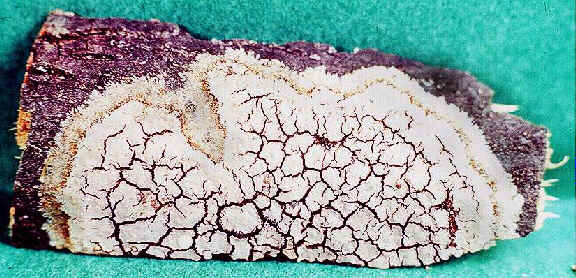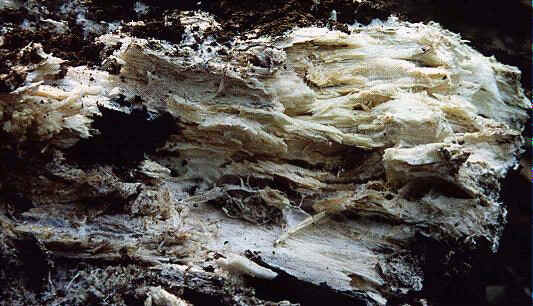

Fungal decay of wood requires the passage of enzymes out of the cell and into the insoluble substrate. Close contact between the hyphal surface and the substrate surface is obviously neccessary to minimise loss by diffusion of both the enzyme and the soluble products of its action.
Fungal attack on wood generally starts by hyphae penetrating through a pit into the narrow central cavity of a cell, after which it grows adpressed to the inner, lignified S3 layer of the wall. The way in which decay proceeds then depends on the enzyme equipment of the fungus. Those that are able to depolymerize lignin as well as cellulose produce a different effect on the cell wall from appearance of the rotten wood; hence the name white rot for rot fungi that decompose lignin, and brown rot for those that only decompose cellulose.
Brown rot fungi are common in nature, attacking living and dead trees, and in a few cases being economically serious causes of decay in building timber. Causative fungi are predominantly Basidiomycetes of the family Coniophoraceae. All these fungi gain a foothold in buildings when timber components are allowed to remain damp over long periods. Fungi cannot grow in wood that contains less than 20% or more than 80% of its weight in water.

Fig. 1: Gloeophyllum sepiarium
Many brown rot fungi can only bring about the decay of cellulose when it is chemically associated with lignin, and are incapable of degrading pure, non-associated cellulose. However, others - which can all decay wood causing a brown rot- are also able to attack non-woody pure cellulosic substrates. The need for lignin to be present in order for some brown rot fungi to be able to decompose cellulose is as yet unexplained.

Fig. 2: Brown rot on decaying tree trunk
Various fungicidal treatments can be used to control timber decay in buildings, but the only long-term cure is to rectify the fault that allowed the wood to get damp.
Basidiomycetes and Ascomycetes are the principal cause of white rots of wood. White rot fungi are far more numerous than brown rot fungi, the latter being exclusively Basidiomycetes. White rots are common on the hardwoods of angiosperm tress, whereas brown rots more usually occur on the softwoods of conifers.

Fig. 3: White rot on decaying tree trunk
Most white rot fungi degrade both lignin and the cellulose, leaving a light, white, rather fibrous residue completely different from the powdery brown remians left by brown rot fungi. However, some, including some of the most serious decay-causing fungi, remove lignin selectively, leaving the cellulose.
White rot fungi have long been known to have biochmeical features which distinguish them from brown rots. They are all capable of decomposing unassociated cellulose by means of enzymes released into the medium. In addition, they all produce phenol-oxidizing enzymes. Any culture of a white rot fungus will oxidize phenols, producing quinones. The function of phenol oxidase activity in nature is not yet fully understood. It has been suggested that the quinone can act as an oxygen donor in an enzymically catalysed oxidative attack on cellulose.
Phanerochaete chrysosporium is one example of white rot fungi. These fungi never form a mushroom for reproduction, but form effused, very flat, fruiting bodies that appear as no more than a crust on the underside of a log ( See below). Microscopically, however, they are quite interesting and even beautiful.

Fig. 4: Phanerochaete chrysosporium
It is a member of the Basidiomycota, which means it bears its meiotic spores externally on a structure called a basidium. On the surface, it is a pretty inconsequential-looking fungus.

Fig. 5: White rot caused by Phanerochaete chrysosporium
However it is the lignin-degrading enzyme system of this fungus that makes it very special. That is, the fungus decays the lignin and leaves the cellulose behind (upper picture). There are many kinds of fungi that cause a white rot, but Phanerochaete chrysosporium has several features that might make it very useful. First of all, unlike some white rotters, it leave the cellulose of the wood virtually untouched. Secondly it has a very high optimum temperature (about 40oC), which means it can grow on wood chips in compost piles, which attain a very high temperature.